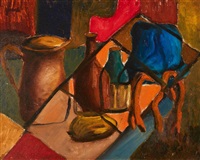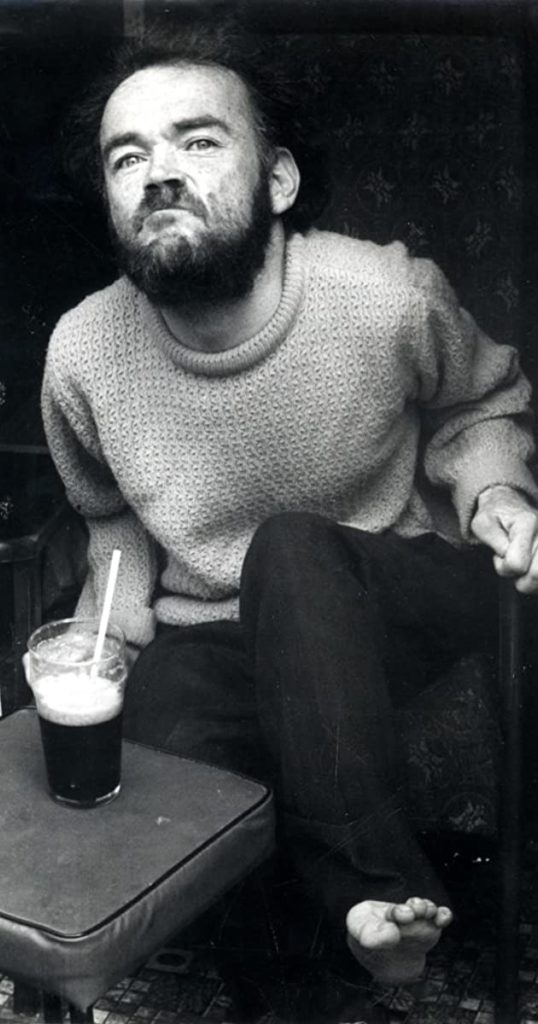
Dear Reader
The painting that graces this issue is by Irish painter and writer Christy Brown. Also featured are educators and incurable romantics Wendy and Phil Allen, legendary soul singer, Curtis Mayfield, and wheelchair rider Susan Sygall.
I hope you agree that people with disabilities influence every aspect of life. And that any barrier that prevents them from performing at their peak is society’s loss.
I’m trying something new in this issue, embedding videos. Let me know if the links work and whether you like this feature.
You can help rewrite history by sending your comments and suggestions for future issues via this form. And if you like what you’re reading please spread the word.
Enjoy – Al
PS: Check out my six part podcast series The Power of Disability. The last two episodes are with:
Penny Parry and Tim Louis who share stories and reflections from 40 plus years of working on social issues in their own careers and together as a couple.
And Barb Goode the queen of self advocacy and plain language. She is a global change-maker and unsung hero of the disability movement.

June 2nd is the thirty-seventh anniversary of Phil and Wendy Allen’s marriage (1984). Theirs is a love story for the ages. Think Anthony and Cleopatra or Romeo and Juliet, but without the tragedy. Just as intense and passionate, but more joyful and long-lasting.
Wendy and Phil had movie star good looks. They married in an era when many people with disabilities were prevented from having a relationship let alone marry. “Not letting people get married if they want to be together is very cruel,” said Phil. “Whether you’re handicapped or not doesn’t mean you can’t love somebody or you can’t clean up the house.”
“We met at a friend’s party and it was, what do you call it, love at first sight,” recalled Wendy. “I thought he was so nice. A cool guy.”
“Wendy looked just beautiful on our wedding day,” said Phil. “I looked pretty good too. Yep, that was a nice day. It was a little cloudy in the morning and cleared up in the afternoon.”
Wendy and Phil had a lot in common. They collected records, lapel pins, and spoons. They had a Christmas display in their apartment that would rival a major department store. Wendy hosted a radio show for years. Phil was always in demand as a public speaker and taught college and university classes.
Phil was twenty-eight years older than Wendy. He spent the early years of his life in an institution where “the only thing they taught you was how to feel forgotten.” He was afraid of being put into a nursing home. “That’ll never happen as long as I’m around to take care of you,” Wendy promised. “That’s part of the deal when you are married, you know.”
Phil Allen died on September 11, 2017. Wendy kept her promise.
For a deeper profile of Phil and Wendy’s love story read, Couples with Intellectual Disabilities Talk about Living and Loving by Karin Melberg Schweir.

June 3rd is the birthday of soul singer and songwriter Curtis Mayfield (1942). Mayfield provided the soundtrack for the civil rights movement. His songs include, People Get Ready, from his days with his first group The Impressions, and Keep on Pushing which was Martin Luther King Jr’s favourite.
Mayfield grew up in one of Chicago’s low-income housing projects. “With everything I saw on the streets as a young black kid, it wasn’t hard during the later fifties and sixties for me to write my heartfelt way of how I visualized things, how I thought things ought to be,” he said.
In 1990 a freak accident occurred during an outdoor concert in Brooklyn. A major wind storm toppled stage lighting equipment which fell on Mayfield. He was paralyzed from the neck down. After a lengthy recovery, he released his final album, New World Order. Mayfield recorded the album lying on his back recording one line at a time because that’s all the air he could get into his lungs. “How many 54-year-old quadriplegics are putting albums out? You just have to deal with what you got, try to sustain yourself as best you can, and look to the things that you can do,” he said.
Mayfield was inducted into the Rock and Roll Hall of Fame, won a Grammy Legend Award, a Grammy Lifetime Achievement Award and was inducted into the Grammy Hall of Fame twice.
He died from complications of type 2 diabetes at the age of 57 on December 26, 1999. “We’re all human beings, so we can get angry and bitter or mad, but for me, it doesn’t last long,” he said. “I’d rather be humble and cry tears of joy than to take on the stress and burdens of being dogged out and negative.”
The song, Back to Living Again was recorded after his accident.

June 4th is the birthday of artist, author and global disability rights activist. Susan Sygall (1953). A car accident when she was 18 turned Sygall into a self described “happy wheelchair rider.” She was never angry about being disabled. “I was angry about discrimination,” she said. In 1981 she co-founded Mobility International to promote full citizenship for disabled people wherever they live in the world.
Their signature program is the Women’s Institute on Leadership and Disability (WILD) which brings women with disabilities from around the world for a three-week retreat in Oregon.
The joyful music video Loud Proud and Passionate captures disabled women activists from 45 countries celebrating their global sisterhood.
Sygall has received numerous awards for her work including a MacArthur Fellowship which is sometimes called the genius grant. She is also a member of the prestigious Ashoka global fellowship of social entrepreneurs.
Sygall’s memoir No Ordinary Days describes how she used her wheelchair to transport her on a rolling adventure exploring the inner and outer dimensions of her life. Her years of activism have taught her “You need to be surrounded by people who believe in your dreams, who will work with you for however long it takes and those who know how to celebrate victories.” Nowadays her activism has shifted from “inclusion to infiltration” into society’s institutions. “Behaviour change is motivated by law,” she explains.

June 5th is the birthday of Irish poet, writer and painter Christy Brown (1932). Brown was born with a gift for story telling. He had cerebral palsy and used his left foot for typing and painting. He published his best selling autobiography, My Left Foot in 1954. Brown credited his mother for refusing to send him to an institution and for teaching him to read and write. “From the gutter of my defeated dreams you pulled me to heights almost your own,” he wrote of his mother.
This excerpt from My Left Foot describes the event that changed his life and gave his mind “its chance of expressing itself.”
My hands were so tightly clenched that my fingernails bit into the flesh. I set my teeth so hard that I nearly pierced my lower lip. Everything in the room swam till the faces around me were mere patches of white. But I drew it, the letter “A”. There it was on the floor before me. Shaky, with awkward, wobbly sides and a very uneven centerline. But it was the letter “A.”
That one letter, scrawled on the floor with a broken bit of yellow chalk gripped between my toes, was my road to a new world, my key to mental freedom.
Brown’s next book, Down All the Days was published in 1970. It was described as the most important novel since James Joyce’s Ulysses. It became an international best seller and was translated into multiple languages. Brown became a celebrity and with the proceeds of his book sales built a custom designed house.
Christy Brown died on September 7, 1981. My Left Foot was adapted for the big screen and released in 1989.
For a short interview with Brown see the video below.
Did you know?
One of the earliest representations of disability was Hephaestus the Greek god of fire. He was the son of Zeus, king of the gods and Hera, queen of the gods. The Romans called him Vulcan. Accounts vary as to the origin of his disability. One legend has him thrown off Mount Olympus because he was born “shrivelled of foot.” Another suggests his foot was severely injured in the fall.
Hephaestus was the only Greek god who worked. He was a talented blacksmith who made the armour for Achilles. He is often portrayed as a working class hero and the god of technology. He and his wife Athene are considered the founders of civilization by the Greek poet Homer.
The winged chariot of Greek mythology may have been the first wheelchair. It was designed by Hephaestus to assist him to get around. Image description: Hephaestus returns to Olympus riding a winged chariot-car or chair. The chair is decorated with the heads, wings and tail of a crane. The god carries a double-headed smith’s mallet.
Image description: Hephaestus returns to Olympus riding a winged chariot-car or chair. The chair is decorated with the heads, wings and tail of a crane. The god carries a double-headed smith’s mallet.
Receive your weekly copy of the Disability Digest.
